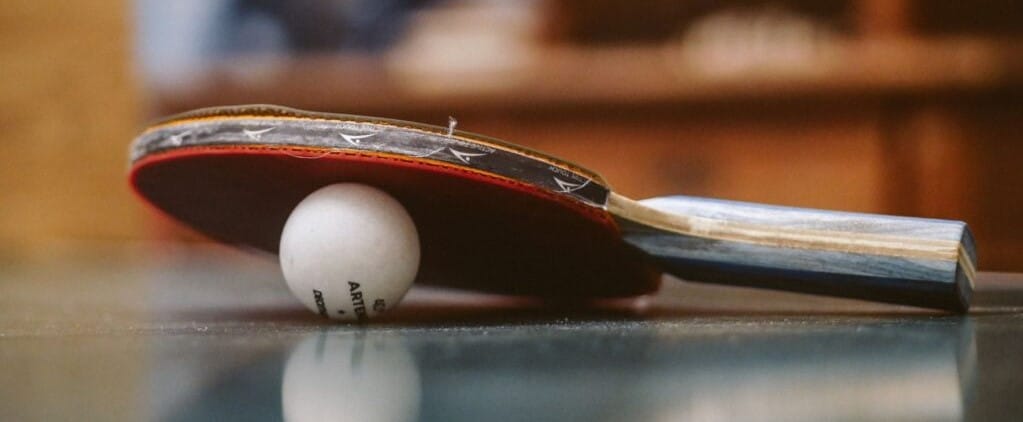Table tennis rubber doesn’t last forever and it’ll need replacing after a while to make sure you get the best performance from your paddle. In this article I’ll explain how long rubber lasts on average, the factors that affect the durability and how to know when it needs replacing.
How Long Does Table Tennis Rubber Last?
Most table tennis rubbers last for 75-100 hours of playing before they need replacing. Inverted rubber is the least durable and usually lasts between 80-100 hours, whereas pimpled and anti-spin rubbers can last over 100 hours. Most table tennis players replace their rubbers every 6-12 months.
Here is a comparison of the different types of table tennis rubbers and their lifespan.
| Rubber Type | Excellent Condition | Good Condition | Okay Condition | Poor Condition |
| Inverted | 60 hours | 60-80 hours | 80-100 hours | 100 hours + |
| Pimpled/ Anti-Spin | 75 hours | 75-100 hours | 100-120 hours | 120 hours + |
Here is how often the average player needs to replace their rubber based on how often they play.
| Replacement Frequency | Inverted Rubber | Pimpled/ Anti-Spin Rubber |
| Training 2 hours/ week | 50 weeks (11.5 months) | 60 weeks (14 months) |
| Training 4 hours/ week | 25 weeks (6 months) | 30 weeks (7 months) |
| Training 8 hours/ week | 12.5 weeks (3 months) | 15 weeks (3.5 months) |
| Training 10 hours/ week | 10 weeks (2.5 months) | 12 weeks (3 months) |
| Training 12 hours/ week | 8 weeks (2 months) | 10 weeks (2.5 months) |
The lifespan of table tennis rubber depends on the type of rubber being used and the playing style of the person using the paddle.

Types of Rubber and Durability
Inverted rubber does not last as long as pimpled and anti-spin table tennis rubbers. Chinese-style rubbers also tend to be more durable than European/ Japanese tensor style table tennis rubbers which often need replacing more frequently.
However, the exact make and model of the rubber also makes a difference. For example, Butterfly Tenergy is longer lasting than many other types of European/ Japanese tensor rubbers and even many Chinese-style rubbers.
Check out the table below to see the average durability (amount of playing time before the rubber needs replacing) for different types of rubber with examples.
| Rubber Style | Average Durability | Example |
| Standard Tensor | 60-80 hours | Butterfly Flextra |
| High Quality Tensor | 80-100 hours | Butterly Tenergy |
| Chinese (tacky) | 80-100 hours | DHS Hurricane 3 |
| Short Pimple | 100-120 hours | Friendship RITC 802-40 |
| Anti-Spin | 120 hours + | Yasaka Anti Power |
| Long Pimple | 120 hours + | CTT National Pogo |
The softness of the rubber will also contribute here. Chinese rubbers often last a long time because they are very hard. The softer the rubber is, the quicker it tends to wear out and need replacing.
Take the Stiga Mantra range as an example. When you look on revspin.net which complies user ratings of different types of rubber, the softest variant has a lower durability score compared to the hardest variant.
Stiga Mantra Variant Durability Score:
Soft = 6.2
Medium = 7.4
From revspin.net
The colour of the rubber also can make a difference.
Most players use black rubber on the forehand and red rubber on the backhand side of the paddle. There is a difference in the dyeing process of red and black rubbers which gives them different characteristics. Black rubbers are more tacky and provide more spin than red rubbers.
Black table tennis rubber also lasts longer than red rubber as it stays tackier for longer. This is useful because Chinese players use black rubber on the forehand side and most players are forehand dominant, so this means the forehand side won’t wear down too quickly.
Check out my comparison between red and black rubbers for more info.
Playing Style and Wear
Your playing style will also impact how quickly the rubber needs replacing on a ping pong paddle.
Players who have an attacking style of play with a lot of top spin or back spin, and hit the ball harder are likely to wear their rubber out more quickly. Players with a more defensive or counter-attacking style and rely more on blocking will often find that the rubber lasts longer.
When you choose your table tennis rubber, consider the different types mentioned above and also consider your playing style. An offensive player who uses a lot of spin will often find that a soft tensor style rubber won’t offer them as much durability as something like Butterfly Tenergy or DHS Hurricane.
Professional players will need to replace their rubber more frequently not only because they play more often and need to maintain the best performance, but also because they usually apply more spin and speed to the ball which causes the rubber to wear out more quickly.

How to Know When the Rubber Needs Replacing
Table tennis players can identify when their paddle rubber needs replacing by assessing how tacky it feels. If the rubber feels smoother in the center of the paddle, then this is a sign that the rubber needs replacing. This can be assessed using your hand or by dragging a ball across the paddle so you can feel the difference.
For different styles of rubber there are different ways of identifying when it needs replacing:
- Inverted (smooth) rubber: drag a ping pong ball over the rubber and see if the surface feels smoother in the middle. If it does, it’s time to replace the rubber.
- Pimpled rubber: if the pips have worn down in a certain area (usually the middle of the paddle), you have many pips missing, or the surface feels much smoother, then the rubber will need replacing.
- Anti-spin rubber: if the grip of the rubber feels different across the paddle in certain places then the rubber should be replaced.
Table tennis rubber needs replacing when it becomes worn because it affects the speed, spin and control of the paddle. Older rubbers lose their tackiness and the sponge layer also becomes softer and loses its elasticity which reduces the amount of power and spin you can generate. Older rubber also feels inconsistent, meaning the ball will bounce and react to the paddle differently on the edges compared to the middle of the paddle, making it harder to control the ball.
How to Replace the Rubber
- Carefully and gently peel the rubber and sponge layer of your paddle by starting at the edges.
- Sand the blade to remove any residual glue if necessary.
- Apply a small amount of water-based glue to your blade and spread it evenly using a paint brush so there is a thin layer coating it.
- Apply a small amount of water-based glue to your rubber and spread it evenly using a paint brush so there is a thin layer coating it.
- Wait approximately 10-15 minutes for the glue to dry to-the-touch.
- Place the rubber on the blade so the logo is lined up with the top of the handle and roll it up the blade pressing firmly down to remove any air bubbles.
- Cut around the blade to remove the excess rubber using either scissors or a Stanley knife.
- Remove the plastic film on the rubber.
Check out this video by PingSkills on YouTube for a demonstration.
Storage and Cleaning
If you want to maximise the lifespan of your table tennis rubber then you’ll need to keep it clean and store your paddle properly.
- Use a dedicated table tennis rubber cleaner and sponge to clean your rubber after every few hours of playing to keep it in the best possible condition.
- Make sure you store your paddle in a case to keep it clean and prevent it from drying out so maximise the durability of the rubber.
Check out these options on Amazon to look after your paddle.
Does Table Tennis Rubber Expire?
Most table tennis rubbers have an expiry date of 2-3 years from the date of manufacture. Suppliers may hold onto the rubber for a few months before selling it, so it is a good idea to put the rubber on your paddle within a year of purchasing it to make sure it is still in good condition.


